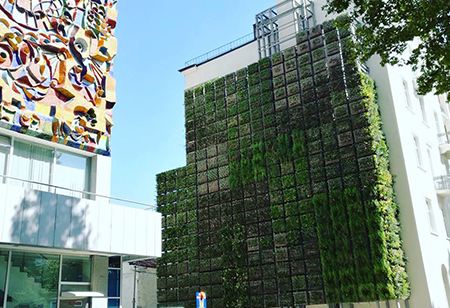Going green: Vertical garden takes shape in Tbilisi

A new vertical garden is coming to life in Georgia’s capital city.
Workers are now installing small sections of greenery to a metal frame to create the new vertical garden, located on the wall of a building at 59 Aghmashenebeli Ave in Marjanishvili district.
The vertical garden is part of the Government-initiated New Tiflis project, which involved restoring some of the city’s oldest houses, creating pedestrian-only waking areas and adding new green areas to the city to make Tbilisi more environmentally-friendly and tourist-friendly.
Today the garden was being fitted to the metal frame, and once completed workers will connect a drip irrigation system to keep the plants healthy.

Workers are installing small sections of greenery to a metal frame to create the new vertical garden. Photo by Tbilisi Development Fund.
The new vertical garden in Marjanishvili is located on a street that will soon be a pedestrian-only zone.
It is Tbilisi’s second vertical garden. The original vertical garden is located in Avlabari district at the entrance to the Avlabari Metro station.
Click here and find more information about Tbilisi’s new pedestrian-only zones.
The New Tiflis project launched in February 2016 and was due to be completed by the end of the year.
The Tbilisi Development Fund, which operates under the Tbilisi Mayor’s Office, is responsible for the development project, which primarily involved restoring buildings on Aghmashenebeli Ave.

These photos by the Tbilisi Development Fund show an Aghmashenebeli Ave building before and after restoration.
This week the Tbilisi Development Fund announced the major restoration works were coming to an end and the majority of facades on the old buildings had been completely restored.
Additionally, the street had been dug up and fitted with new sewage systems and communication lines.
The New Tiflis Project rehabilitation works focused on three things: restoration of the old buildings, replacing old sewerage and communication systems and repairing the road.

The restoration works are coming to an end on Aghmashenebeli Ave in Marjanishvili district. Photo by Tbilisi Development Fund.
In total 45 buildings needed to be restored, of which 38 were deemed historic cultural monuments.
The majority of houses have already been rehabilitated while all works are due to be completed before the end of September, announced the Tbilisi Development Fund.
More than 200 professionals such as architects, historians, urbanists, art critics and others were involved in the project and worked with the Government to develop an urban environment plan for Tbilisi so its 1.5 million residents and visitors can enjoy the city’s cultural and diverse landscape.
 Tweet
Tweet  Share
Share